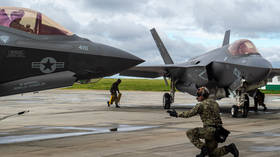Speed, performance, privacy & pain: But Pentagon says F-35 issues have ‘acceptable workarounds’

As an F-35 flew over the White House to impress President Donald Trump and his Polish counterpart, a damning report outlined a litany of potentially fatal issues with the jet the Pentagon wants to greenlight for full production.
Documents obtained by Defense News point to 13 severe technical issues that still plagued all three variants of the F-35 as of late 2018. While some of these problems had already been made public, many were revealed for the first time. It also marks the only time such a comprehensive list of the F-35's most severe issues has been put together at any point in the fighter's troubled development.
One of the previously unknown issues were concerns over data privacy affecting the international partners of the F-35 program, which nearly caused two governments to back out. The plane's cloud-based Autonomic Logistics Information System (ALIS) was reportedly giving the Pentagon and Lockheed Martin unchecked access to foreign air forces' private data. A data-guard has since been developed to restrict this access.
Vice Admiral Mat Winter, head of the F-35 program at the Pentagon since 2017, said he was not aware that any nations had threatened to pull out of the program over privacy concerns.
Troubling issues were also noted with the F-35's B and C variants, developed for the US Marine Corps and Navy respectively. Tests found that the heat generated by the jet's afterburners could damage the structure of the fighter or the low-observable paint that gives the F-35 its stealth capabilities. As a result, pilots were restricted to flying at speeds below Mach 1.2.
Also on rt.com F-35 jets conduct White House flyover (VIDEO)Both models also had maneuvering difficulties when engaging in aerial dog-fights, severely limiting their effectiveness in missions to intercept enemy aircraft. Test pilots experienced unpredictable handling and rolling of the aircraft after undergoing "high angle of attack" maneuvers, which put pilots and the plane at risk.
One of the top concerns, however, was with two Air Force test pilots who complained of "excruciating" ear and sinus pain after sudden spikes in cockpit pressure during flight testing. Pilots had to abort their missions after losing "in-flight situational awareness" and continued to experience "lingering symptoms" in the months afterwards.
Admiral Winter told Defense News that none of the 13 problems mentioned would affect the Pentagon's final decision to enter full-rate production. Lockheed Martin also expressed confidence in their design, noting in a statement that the 13 issues were "well understood, already resolved or on a near-term path to resolution."
Also on rt.com US won't train any more Turkish F-35 pilots as Ankara refuses to ditch S-400 – report“We have no CAT 1-A deficiencies,” Winter said, referring to potential loss of life and aircraft issues that have to be resolved immediately. He explained that all the listed problems fall under category 1-B, which indicates they have a “current workaround that’s acceptable to the war fighter with the knowledge that we will be able to correct that deficiency at some future time.”
Designed to replace most fighter aircraft in the US arsenal, the F-35 has been in development for nearly two decades. The Pentagon was expected to announce the end of development phase in 2018 and enter full-rate production. Ongoing issues with the design have led to repeated delays and ballooning costs, however. Official projections put the program’s lifetime cost at over $1.5 trillion.
Think your friends would be interested? Share this story!















